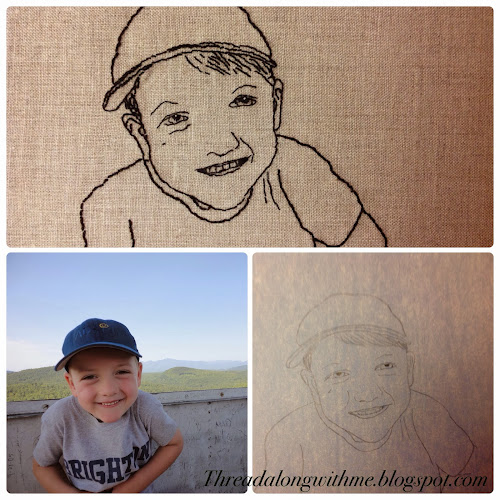One of the things I wanted to do during my stitching retreat last weekend was to try embroidered portraits. I had seen them on Pintrest and traced the photo back to the original tutorial on the Habit of Art blog. It seemed easy enough to enlarge a photo, trace it and embroider it. It was a little more difficult than it seemed though!
I don't really draw, although the one drawing class I took a few years ago really helped me understand some of the principles behind drawing and gave me confidence. Still, tracing photos is much harder than I hoped it would be. I started with two photos of my nephew, Simon, and two photos of my husband's grandson, Dracen. The plan was to make two embroidered portraits of each child--one for each parent. Unfortunately, of the four tracings, I made, only two looked at all like the children. One made Dracen look like a little hobbit rather than a baby. My husband, who went to art school, gave me some tips. He told me that I didn't need to trace all the lines I saw, or even close all the shapes. That helped a lot. It also helped having multiple photos, since I could hone in on what lines were character defining. For example, the line under Simon's eye appears in every photo I saw of him and made him look impish. I needed that, but I left out his cheek and the line under his other eye.

After tracing the photos and getting them to look how I wanted them. I was afraid to draw them into the fabric, so I photocopied them onto Stitch 'n Wash, a sticky dissolvable interfacing and basted the photos onto linen. That way I had less distortion. I had never used A dissolvable interfacing before, but I highly recommend it.
Embroidering was relatively easy. I used one strand of DMC floss for the eyes and facial features, No.12 pearl cotton for the head shapes and some details, and No. 8 pearl cotton for the clothes and some hair. It was a fun experiment.
Now all I have to do is frame the finished embroideries. I will use the same Ikea frames recommended in the tutorial, but I left enough fabric to be able to lace the portraits around a mount rather than taping them to a mat as shown in the tutorial. I'm looking forward to doing two more for the other two parents, but I will keep looking for photos that are easier to trace. Of everything I learned, the two most important tips for anyone who may want to try this technique are to have a variety of photos to choose from because some are easier to translate into line drawings than others, and to use the dissolvable interfacing. Once you get that tracing perfect, you don't want to trace it again!















